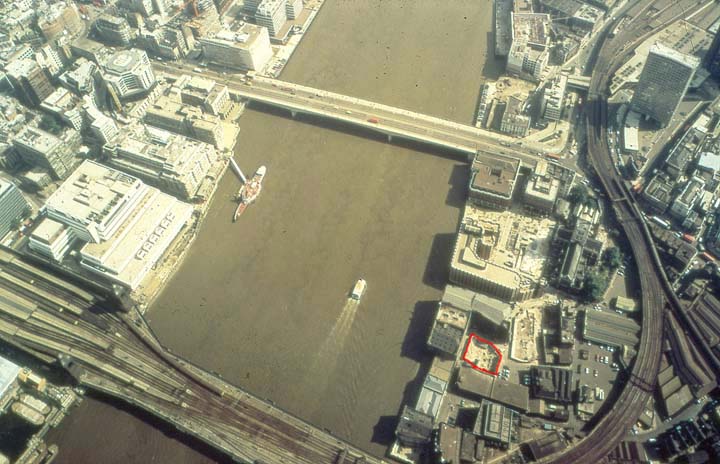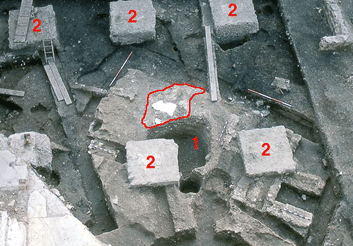The Winchester Palace Roman wall paintings were discovered in October 1983 when archaeologists from the Museum of London's Department of Greater London Archaeology investigated a site in North Southwark once occupied by a palace belonging to the mediaeval Bishops of Winchester. This palace occupied a position on the south bank of the river Thames, some 250 metres west of London Bridge and 50 metres west of Southwark Cathedral, and thus gave the site its seemlingly misleading name.
Location
A simplified layout of the plan of of Building 13. Several heated rooms and the position of the fallen painted plaster are shown. The capital letters distinguish the different rooms in the complex and are the same as those used in the Museum of London's publication.
The capital letters used label the different rooms in the complex are the same as those used in the Museum of London's publication.

For those seeking a detailed and thorough analysis of the site, and its archaeology, the Museum of London's publication,"Excavations at Winchester Palace, London, 1983-90, Brian Yule." MOLAS Monograph 23. 2005. should be consulted.

The aerial photograph, shown above, was, fortuitously taken during the 1983 excavations. The area of the Winchester Palace site that contained the Roman painted plaster is outlined in red at the lower right hand corner of the photograph.
An overhead photograph, taken from an adjacent building, showing the area of the site containing the collapsed Roman painted plaster, outlined in red. The feature labelled "1" was a post medieval well that clipped the spread of painted plaster. The features labelled "2" are concrete pillar bases from the 19th.century building that stood on the site.

Excavation revealed that beneath the foundations of the mediaeval palace lay the remains of a series of Roman buildings dating from the first to the fourth centuries A.D. The wall paintings were discovered in the robbed out ruins of a room belonging to a building originally constructed about 120 A.D. This building seems, from its stone construction, vaulted ceilings and extensive sub floor heating system, to have been part of a large baths complex. When the building was demolished, sometime in the late third or the fourth century, the internal clay wall supporting the painting collapsed and fell with the paintings face downwards on to the robbed out hypocaust, and although broken into many hundreds of pieces, lay there, more or less undisturbed, for some sixteen hundred years. The paintings were protected by the fabric of the wall itself and by its location within what had become the Bishop of Winchester's garden. Later, as the photograph above shows, a post mediaeval well,'1' penetrated the lower left hand edge of the mortar spread. Also to be seen in the photograph are the 19th. century square concrete pillar bases '2' belonging to the warehouse whose redevelopment prompted the archaeological excavation.
A computer drafted reconstruction of this part of the baths complex is shown below, with some walls and the ceiling removed, to show the painting in its original position, filling the lunette over the doorway into the adjoining room.
